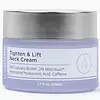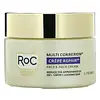What's inside
What's inside
 Key Ingredients
Key Ingredients

 Benefits
Benefits

 Concerns
Concerns

 Ingredients Side-by-side
Ingredients Side-by-side

Water
Skin ConditioningAloe Barbadensis Leaf Juice
Skin ConditioningDiisooctyl Succinate
EmollientTheobroma Grandiflorum Seed Butter
Skin ConditioningDiisopropyl Dimer Dilinoleate
EmollientPropanediol
SolventLimnanthes Alba Seed Oil
Skin ConditioningHydrogenated Ethylhexyl Olivate
EmollientHydrogenated Olive Oil Unsaponifiables
EmollientCaprylic/Capric Triglyceride
MaskingSimmondsia Chinensis Seed Oil
EmollientCetearyl Olivate
Sorbitan Olivate
EmulsifyingCetearyl Alcohol
EmollientCetyl Palmitate
EmollientSorbitan Palmitate
EmulsifyingSorbitan Oleate
EmulsifyingHydrolyzed Hyaluronic Acid
HumectantPiperonyl Glucoside
Skin ProtectingGlycerin
HumectantLecithin
EmollientCaffeine
Skin ConditioningPalmitoyl Carnitine
Skin ConditioningHydrolyzed Plukenetia Volubilis Seed Extract
Emulsion StabilisingGeranium Maculatum Extract
TonicEquisetum Arvense Extract
AstringentHamamelis Virginiana Bark/Leaf/Twig Extract
Skin ConditioningTaraxacum Officinale Extract
Skin ConditioningPropolis Extract
Skin ConditioningCamellia Sinensis Leaf Extract
AntimicrobialCentella Asiatica Extract
CleansingOryza Sativa Bran Extract
Skin ConditioningRosmarinus Officinalis Leaf Extract
AntimicrobialHelianthus Annuus Seed Extract
Skin ConditioningTocopherol
AntioxidantSimmondsia Chinensis Seed Extract
AbrasiveTamarindus Indica Seed Polysaccharide
Skin ConditioningLavandula Angustifolia Oil
MaskingCitric Acid
BufferingSclerotium Gum
Emulsion StabilisingPotassium Sorbate
PreservativeSodium Benzoate
Masking1,2-Hexanediol
Skin ConditioningCaprylyl Glycol
EmollientLonicera Caprifolium Flower Extract
PerfumingLonicera Japonica Flower Extract
Skin ConditioningWater, Aloe Barbadensis Leaf Juice, Diisooctyl Succinate, Theobroma Grandiflorum Seed Butter, Diisopropyl Dimer Dilinoleate, Propanediol, Limnanthes Alba Seed Oil, Hydrogenated Ethylhexyl Olivate, Hydrogenated Olive Oil Unsaponifiables, Caprylic/Capric Triglyceride, Simmondsia Chinensis Seed Oil, Cetearyl Olivate, Sorbitan Olivate, Cetearyl Alcohol, Cetyl Palmitate, Sorbitan Palmitate, Sorbitan Oleate, Hydrolyzed Hyaluronic Acid, Piperonyl Glucoside, Glycerin, Lecithin, Caffeine, Palmitoyl Carnitine, Hydrolyzed Plukenetia Volubilis Seed Extract, Geranium Maculatum Extract, Equisetum Arvense Extract, Hamamelis Virginiana Bark/Leaf/Twig Extract, Taraxacum Officinale Extract, Propolis Extract, Camellia Sinensis Leaf Extract, Centella Asiatica Extract, Oryza Sativa Bran Extract, Rosmarinus Officinalis Leaf Extract, Helianthus Annuus Seed Extract, Tocopherol, Simmondsia Chinensis Seed Extract, Tamarindus Indica Seed Polysaccharide, Lavandula Angustifolia Oil, Citric Acid, Sclerotium Gum, Potassium Sorbate, Sodium Benzoate, 1,2-Hexanediol, Caprylyl Glycol, Lonicera Caprifolium Flower Extract, Lonicera Japonica Flower Extract
Water
Skin ConditioningTriheptanoin
Skin ConditioningStearyl Alcohol
EmollientPrunus Amygdalus Dulcis Oil
Skin ConditioningPersea Gratissima Oil
Skin ConditioningPolyglyceryl-3 Methylglucose Distearate
EmulsifyingGlycerin
HumectantLinum Usitatissimum Seed Extract
PerfumingSodium PCA
HumectantPanthenol
Skin ConditioningSodium Hyaluronate
HumectantProline
Skin ConditioningHydroxyproline
Skin ConditioningCaprylhydroxamic Acid
1,2-Hexanediol
Skin ConditioningPropanediol
SolventCoco-Caprylate/Caprate
EmollientDilinoleic Acid
EmollientSimmondsia Chinensis Seed Extract
AbrasiveCaprylyl Glycol
EmollientButyrospermum Parkii Butter
Skin ConditioningDimethicone
EmollientDisodium EDTA
Stearic Acid
CleansingHexylresorcinol
AntimicrobialMacadamia Ternifolia Seed Oil
EmollientSimmondsia Chinensis Seed Oil
EmollientSea Water
HumectantGlyceryl Stearate
EmollientCarthamus Tinctorius Seed Oil
MaskingAstragalus Membranaceus Root Extract
EmollientUbiquinone
AntioxidantTocopherol
AntioxidantSpilanthes Acmella Flower/Leaf/Stem Extract
AntimicrobialXanthan Gum
EmulsifyingTocopheryl Acetate
AntioxidantParfum
MaskingCitric Acid
BufferingAminomethyl Propanol
BufferingWater, Triheptanoin, Stearyl Alcohol, Prunus Amygdalus Dulcis Oil, Persea Gratissima Oil, Polyglyceryl-3 Methylglucose Distearate, Glycerin, Linum Usitatissimum Seed Extract, Sodium PCA, Panthenol, Sodium Hyaluronate, Proline, Hydroxyproline, Caprylhydroxamic Acid, 1,2-Hexanediol, Propanediol, Coco-Caprylate/Caprate, Dilinoleic Acid, Simmondsia Chinensis Seed Extract, Caprylyl Glycol, Butyrospermum Parkii Butter, Dimethicone, Disodium EDTA, Stearic Acid, Hexylresorcinol, Macadamia Ternifolia Seed Oil, Simmondsia Chinensis Seed Oil, Sea Water, Glyceryl Stearate, Carthamus Tinctorius Seed Oil, Astragalus Membranaceus Root Extract, Ubiquinone, Tocopherol, Spilanthes Acmella Flower/Leaf/Stem Extract, Xanthan Gum, Tocopheryl Acetate, Parfum, Citric Acid, Aminomethyl Propanol
Ingredients Explained
These ingredients are found in both products.
Ingredients higher up in an ingredient list are typically present in a larger amount.
1,2-Hexanediol is a synthetic liquid and another multi-functional powerhouse.
It is a:
- Humectant, drawing moisture into the skin
- Emollient, helping to soften skin
- Solvent, dispersing and stabilizing formulas
- Preservative booster, enhancing the antimicrobial activity of other preservatives
Caprylyl Glycol is a humectant and emollient, meaning it attracts and preserves moisture.
It is a common ingredient in many products, especially those designed to hydrate skin. The primary benefits are retaining moisture, skin softening, and promoting a healthy skin barrier.
Though Caprylyl Glycol is an alcohol derived from fatty acids, it is not the kind that can dry out skin.
This ingredient is also used as a preservative to extend the life of products. It has slight antimicrobial properties.
Learn more about Caprylyl GlycolCitric Acid is an alpha hydroxy acid (AHA) naturally found in citrus fruits like oranges, lemons, and limes.
Like other AHAs, citric acid can exfoliate skin by breaking down the bonds that hold dead skin cells together. This helps reveal smoother and brighter skin underneath.
However, this exfoliating effect only happens at high concentrations (20%) which can be hard to find in cosmetic products.
Due to this, citric acid is usually included in small amounts as a pH adjuster. This helps keep products slightly more acidic and compatible with skin's natural pH.
In skincare formulas, citric acid can:
While it can provide some skin benefits, research shows lactic acid and glycolic acid are generally more effective and less irritating exfoliants.
Most citric acid used in skincare today is made by fermenting sugars (usually from molasses). This synthetic version is identical to the natural citrus form but easier to stabilize and use in formulations.
Read more about some other popular AHA's here:
Learn more about Citric AcidGlycerin is already naturally found in your skin. It helps moisturize and protect your skin.
A study from 2016 found glycerin to be more effective as a humectant than AHAs and hyaluronic acid.
As a humectant, it helps the skin stay hydrated by pulling moisture to your skin. The low molecular weight of glycerin allows it to pull moisture into the deeper layers of your skin.
Hydrated skin improves your skin barrier; Your skin barrier helps protect against irritants and bacteria.
Glycerin has also been found to have antimicrobial and antiviral properties. Due to these properties, glycerin is often used in wound and burn treatments.
In cosmetics, glycerin is usually derived from plants such as soybean or palm. However, it can also be sourced from animals, such as tallow or animal fat.
This ingredient is organic, colorless, odorless, and non-toxic.
Glycerin is the name for this ingredient in American English. British English uses Glycerol/Glycerine.
Learn more about GlycerinPropanediol is an all-star ingredient. It softens, hydrates, and smooths the skin.
It’s often used to:
Propanediol is not likely to cause sensitivity and considered safe to use. It is derived from corn or petroleum with a clear color and no scent.
Learn more about PropanediolSimmondsia Chinensis Seed Extract is an exfoliant.
This oil comes from the seeds of the desert shrub called Jojoba. It is more commonly known as jojoba oil, a non-comedogenic oil.
Jojoba oil does not contain fragrance and has many fatty-acids, making it a great soothing ingredient.
It also contains Vitamin E, a great moisturizing ingredient. Vitamin E is also an antioxidant and protects your skin against oxidative damage.
This ingredient humectant properties, meaning it helps draw moisture from the air. This helps keep your skin hydrated.
While jojoba has antibacterial properties, it is only able to kill some strains of bacteria.
Studies also show it helps in wound healing. In fact, Indigenous cultures have used jojoba as a moisturizer and to help treat burns for centuries.
Fun fact: Jojoba oil similar to natural human skin sebum, so it has a great effect on dry skin. It is also promising with helping to regulate sebum production.
Due to its fatty acid content, Jojoba oil may not be fungal acne safe. We recommend speaking with a professional if you have any concerns.
Learn more about Simmondsia Chinensis Seed OilTocopherol (also known as Vitamin E) is a common antioxidant used to help protect the skin from free-radicals and strengthen the skin barrier. It's also fat soluble - this means our skin is great at absorbing it.
Vitamin E also helps keep your natural skin lipids healthy. Your lipid skin barrier naturally consists of lipids, ceramides, and fatty acids. Vitamin E offers extra protection for your skin’s lipid barrier, keeping your skin healthy and nourished.
Another benefit is a bit of UV protection. Vitamin E helps reduce the damage caused by UVB rays. (It should not replace your sunscreen). Combining it with Vitamin C can decrease sunburned cells and hyperpigmentation after UV exposure.
You might have noticed Vitamin E + C often paired together. This is because it is great at stabilizing Vitamin C. Using the two together helps increase the effectiveness of both ingredients.
There are often claims that Vitamin E can reduce/prevent scarring, but these claims haven't been confirmed by scientific research.
Learn more about TocopherolWater. It's the most common cosmetic ingredient of all. You'll usually see it at the top of ingredient lists, meaning that it makes up the largest part of the product.
So why is it so popular? Water most often acts as a solvent - this means that it helps dissolve other ingredients into the formulation.
You'll also recognize water as that liquid we all need to stay alive. If you see this, drink a glass of water. Stay hydrated!
Learn more about Water